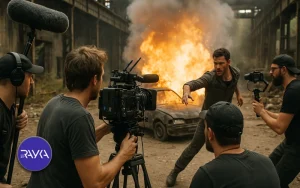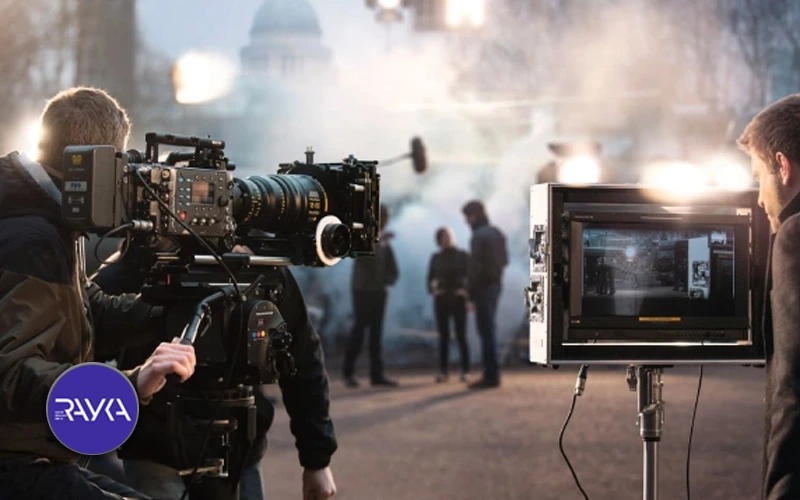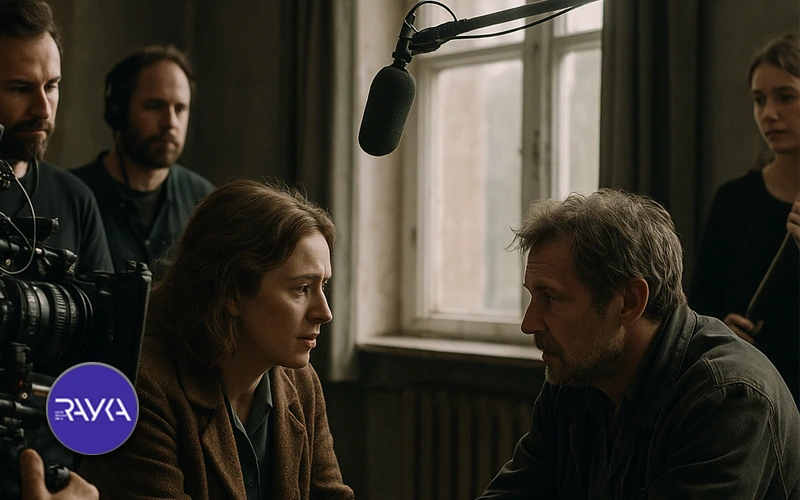
Filmmaking is the art and process of transforming ideas into moving images. This craft can convey emotions, stories, and profound messages in a compelling way to the audience. Many brands and artists use film to showcase products or express their vision.
With technological advancements, filmmaking is no longer exclusive to professionals; anyone can produce high-quality videos using simple tools. In this article, we explore all aspects of filmmaking, introducing its stages, features, and impact.
A film is a series of moving images displayed in a specific sequence. These images tell a story or convey a concept, and they can be either real or fictional. Films are usually accompanied by sound, music, and visual effects to create a complete and enjoyable experience for viewers. Unlike short videos, films have a structured format, and their production requires careful planning and goal setting. Filmmaking helps people craft lasting narratives and spread their culture or message.
Filmmaking is more than just capturing images; it is a powerful tool for influencing and connecting with an audience. Here are the main reasons for making a film:
A good film doesn’t rely solely on expensive equipment or famous actors. It’s the combination of various elements that creates a professional and impactful piece. Below, we explore the key features of a successful film:
| Feature | Description |
|---|---|
| Engaging Story | A coherent story allows the audience to connect with the film. |
| Professional Acting | Actors perform their roles naturally and convincingly. |
| Image and Sound Quality | Clear visuals and crisp audio create an enjoyable viewing experience. |
| Precise Editing | Professional editing provides the film with a proper narrative rhythm. |
| Impactful Music | Appropriate music enhances the audience’s emotions. |
The filmmaking process involves several stages, each playing a crucial role in the final quality of the work. To create a professional film, these steps must be carried out thoroughly and accurately. Below, we explain the key steps in this process.
At this stage, the main subject of the film is determined. Ideation helps clarify the purpose of the film and the message it intends to convey. Typically, the writer or director researches and selects a suitable topic. This stage forms the foundation for the entire project.
Once the idea is finalized, screenwriting begins. The screenplay includes dialogues, scenes, and story details. It serves as the main guide for all production team members. Precise writing ensures the film has coherence and higher quality.
During pre-production, the production team develops a comprehensive plan. This stage involves selecting locations, casting actors, preparing equipment, and scheduling the project. Professional pre-production helps save time and costs and ensures all team members are well-prepared.

Filming is the stage when real footage is captured. The production team records scenes according to the screenplay using cameras, lighting, and sound equipment. The quality of filming greatly affects the visual appeal of the film. Attention to detail is extremely important at this stage.
After filming is complete, editing begins. The editor selects the best shots and arranges them in the proper sequence. Adding music, sound effects, and color correction also takes place during this stage. Final editing prepares the film for release.
To create an impactful film, it’s essential to understand the key elements of filmmaking. These elements help craft a coherent, beautiful, and professional work. The main components are:
Documentary filmmaking is a branch of cinema that depicts real-life events, people, or situations without fictional storytelling. Below, we explore its definition, differences, and applications.
A documentary film is created based on reality, aiming to record, analyze, or represent real events, individuals, or topics. It is produced without fictional storytelling.
Before comparing, it’s important to know that narrative films are built on creativity and imagination with a dramatized structure, whereas documentaries rely on facts. The table below highlights the main differences between these two types of films.
| Feature | Documentary Film | Narrative Film |
|---|---|---|
| Purpose | Present reality and raise awareness | Create a story and entertain |
| Content | Based on research and facts | Based on the writer’s imagination |
| Acting | Real or archival people | Professional actors |
| Structure | No fictional screenplay | Contains a narrative screenplay |
Documentary films have a wide range of applications across various fields. The most important uses include:
In recent years, artificial intelligence has brought significant transformations to the global filmmaking industry. AI can accelerate, reduce costs, and enhance creativity in film production. Many filmmakers now use AI tools for idea generation, editing, special effects, and even screenplay development.
Using machine learning algorithms, filmmakers can analyze audience behavior and understand preferences more accurately. AI also enables automatic dubbing, voice simulation, and scene reconstruction. In the near future, AI will become an essential tool in various stages of filmmaking, making the industry more professional and competitive.

Rayka Mah is recognized as a leader in cinematic video production with AI. Leveraging cutting-edge AI technologies, the team can create high-quality, creative films while significantly reducing production time and cost. With specialized knowledge in this field, Rayka Mah delivers optimal solutions for crafting intelligent and captivating films, shaping the future of filmmaking.
Yes, in today’s world, filmmaking with a smartphone is not only possible but many independent filmmakers and content creators produce professional works using mobile devices. High-quality phone cameras, diverse editing apps, and features like image stabilization and 4K recording make smartphones powerful tools.
If you want to learn smartphone filmmaking, start with the basics of shooting, lighting, and sound. Then work with editing apps like InShot, CapCut, or VN to produce professional and creative videos.
The key to successful smartphone filmmaking is turning limitations into opportunities; creative angles, natural light, and clear audio can largely compensate for expensive equipment. Important tips for successful mobile filmmaking include:
Filmmaking is divided into various branches, with two major ones being realistic (reel) films and narrative films. Both aim to engage the audience, but their objectives, storytelling methods, and execution styles differ significantly. Understanding these differences helps filmmakers or brands choose the most suitable format for conveying their message.
Reel films are based on presenting reality. Their goal is to provide an unexaggerated depiction of life, events, or social topics. Documentaries, reports, or videos showing real-life moments are examples of reel films.
Narrative films are created based on a pre-written script. In these films, characters, stories, and events can be real or fictional, but the main focus is on storytelling and creating an entertaining or impactful experience.
To better understand the difference between reel and narrative films, comparing their features in a table is very useful. This table helps you quickly see each type’s goals and when it is most appropriate to use them.
| Feature | Reel (Realistic) Film | Narrative (Fictional) Film |
|---|---|---|
| Purpose | Present reality and raise awareness | Storytelling and entertaining the audience |
| Source of Content | Real events and documentation | Script and fictional or adapted screenplay |
| Setting/Environment | Realistic and natural | Constructed and often fictional |
| Examples | Social or report documentaries | Narrative feature films |
Filmmaking is a complex art and industry that brings stories to life by combining creativity, technique, and technology. Familiarity with the stages and key elements of filmmaking, the importance of documentary films, and the role of artificial intelligence in transforming this field helps every filmmaker navigate the path to success more effectively.
Artificial intelligence, especially in Iran, is reshaping the film production process. Companies like Rayka Mah, by offering cinematic video production services powered by AI, are creating a bright future for the filmmaking industry.
By learning the fundamentals and leveraging modern technologies, any filmmaking enthusiast can create memorable and captivating works.
To start professionally, first learn the basics such as screenwriting, cinematography, and editing. Then, practice with small projects to gain experience.
Because documentaries present facts in an engaging and evidence-based way, helping to raise audience awareness.
AI optimizes editing, enhances image quality, and creates visual effects, making the filmmaking process faster and more precise.
A strong story, natural acting, professional editing, and well-matched music are key factors for a successful film.
By using modern technologies, Raykamah makes the filmmaking process smarter and provides AI-based cinematic video production services to improve both quality and speed.